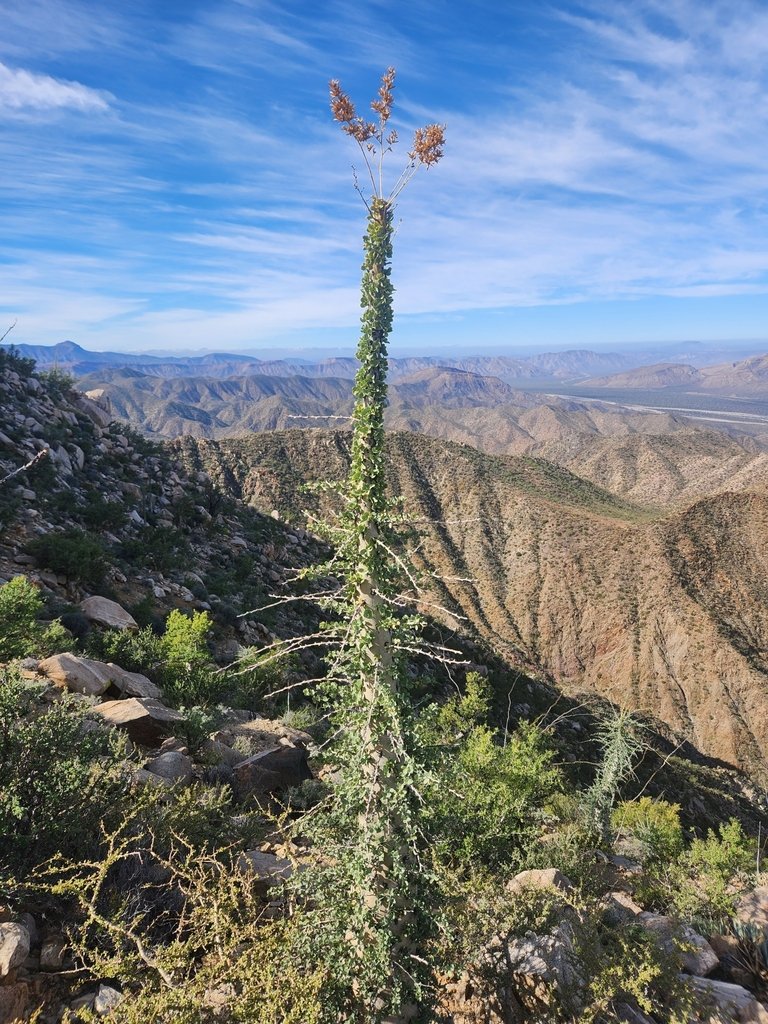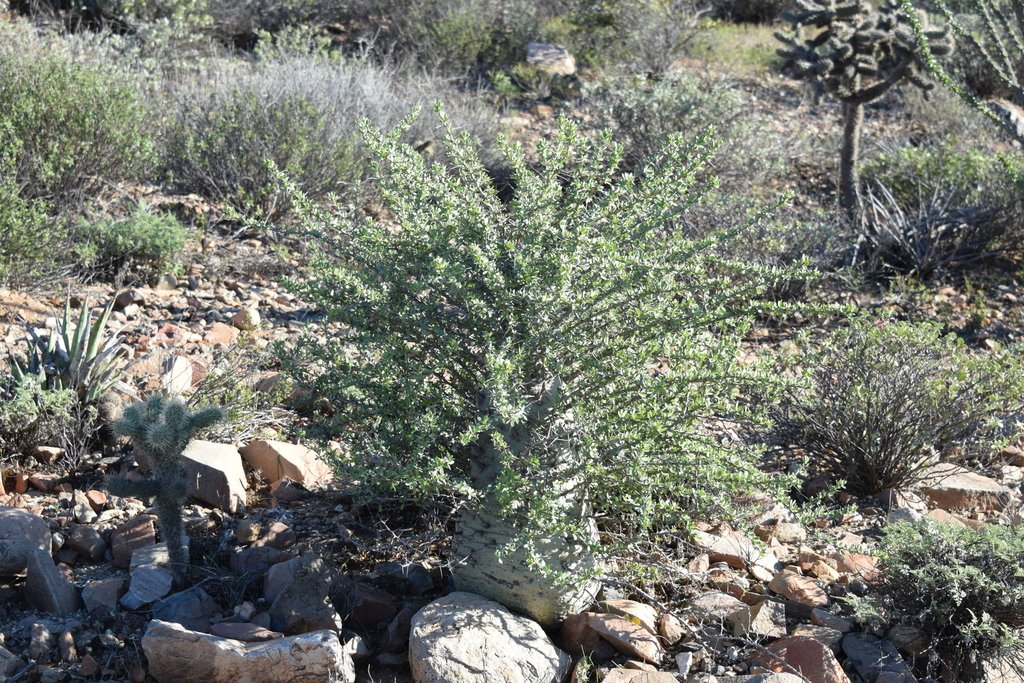Boojum Tree
Fouquieria columnaris
Perhaps one of the most iconic (and strange-looking) plants in the world, let alone its native region of the Baja California peninsula, Mexico, boojum trees look like someone unearthed a giant carrot and planted it upside down. The common name, boojum, was given by Godfrey Sykes of the Desert Laboratory in Tucson, Arizona, and is taken from Lewis Carroll's poem "The Hunting of the Snark". These usually singular stemmed plants can reach more than 80’ tall, though most often they are about 25’ tall. The species has a cortical water-storage network, a feature unique to the family. These singular stems have numerous thin, twiggy branches sticking out at right angles, all covered with small leaves which appear on the plant in the cool season—they go dormant in late spring and are leafless in summer. The flowers bloom in August and September (as the leaves re-emerge) regardless of rainfall; they occur in short racemes, and have a honey scent. The flowers have short, cream-yellow corollas, with the limb of the petals inflexing around the filaments of the stamens. The anthers and stamens protrude out, while the stigma is protected by the inflexed petal limbs. The flowers are visited by at least 15 species of bees in 11 genera, who pry open the inflexed corolla limbs to obtain the sweetened nectar and contact the protected stigma. Growth rate is painfully slow in the early years, picking up to moderate as the plant reaches a foot tall.
The most important thing about growing boojum trees is to provide excellent drainage, and not to keep them wet in summer when they are dormant—they are prone to rotting. The older and larger the plant gets, the more prone to rotting they are in summer. Summer rains are not an issue if the plant is planted in the ground and the drainage is good. Make sure they are not in the bottom of a basin where too much water will collect. In the ground, give deep waterings every 2-3 weeks when in leaf. In containers, water thoroughly about once a week. It is possible to keep them in leaf later into the spring, but watering should be cut back to about once every 3-4 weeks once leaves drop. Fertilize between November and February. Plant in full sun. Young plants (< 1' tall) should be protected against freezes below 25°F. Larger plants can take temperatures down in to the lower 20's or even lower—plants in cultivation are found in some surprising areas, including in Safford, Arizona where it gets much colder.
The roots of the boojum tree contains all structures of an arbuscular mycorrhizal (AM) association. Morphologically different species of mycorrhizae, 23 in number, have been identified in close vicinity to the boojum tree.
Some of the specialist bee species that use the flowers are present in our region. Raptors frequently nest in the crotch of some upper branches. The lace lichen (Ramalina menziesii), or Orchilla, grows on the Boojum in such abundance that in the late nineteenth century the Orchilla was collected and sold for the production of dye. In some areas the epiphyte Ball Moss (Tillandsia recurvata) covers it as well. Besides bees, other organisms visit the flowers including hummingbirds.
The peculiar distribution pattern of boojums has led some botanists to conclude that the disjunct population found in Sonora were probably transplanted to the mainland by the indigenous Seri people, who lived in this area and still live on communal property south of their Sonoran location. The Seri name for this plant is cototaj. In Seri belief, touching this plant will cause strong winds to blow (an undesirable state). Given this belief, the hypothesis that the Seri people transplanted it is doubtful.
Ethnobotanical uses are not well-documented but plants in this genus have been used as medicine almost wherever they occur. Flowers are edible.
This species was previously placed in the monotypic genus Idria. However, this taxonomic classification was created before the vegetative and floral structures of F. fasciculata and F. purpursii were understood, as these two species share intermediate characteristics between the genera Idria and Fouquieria. The species, columnaris, refers to the way it grows in a columnar pattern, which is unique to this species in this genus. Another common name for the plant is in Spanish, Cirio, which translates to “fat candle”.
The boojum grows throughout the Vizcaíno region of the Sonoran Desert in Baja California, and in a single mountain range on the coast of northern Sonora, Mexico.
Boojums contribute to one of the most unusual landscapes in the world, found in Baja California. Photo by Liliana Ortiz Serrato, iNaturalist
Boojums don't always grow straight up. Photo by Angie, iNaturalist
Leaves occur on both the main trunks, and on the branches. Photo by Carlos Gonzalez, iNaturalist
Young plants may have branches that exceed three feet wide, and the trunks will be very wide relative to their height. Photo by Cristian A. D. Meling L., iNaturalist
Flowers occur in late summer (August, September) when the leaves start to re-emerge. Photo by Erik Meling, iNaturalist
Flower detail, photo by Jose Luis Leon de la Luz, iNaturalist
The seed capsules of boojum tree. Photo by Irene, iNaturalist








